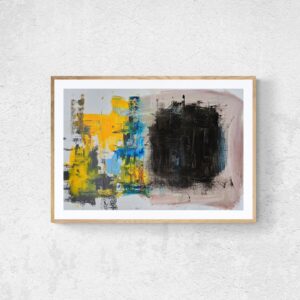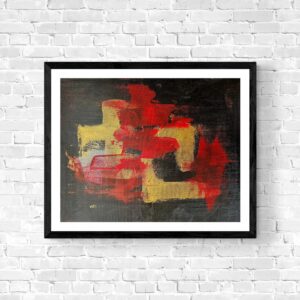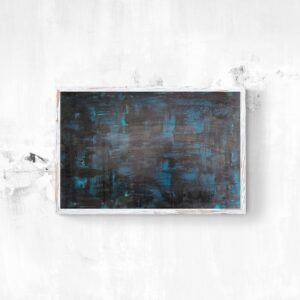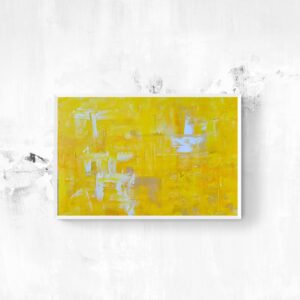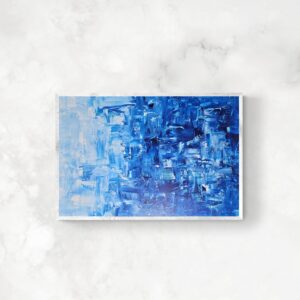
Shanghai-born, Tokyo-based artist Lu Yang transforms the Museum of the Moving Image into a dazzling temple of digital devotion. Guided by an Escher-like checkerboard floor, visitors enter “The Great Adventure of Material World” (2019–20), a hypnotic arcade where Buddhist cosmology refracts through gaming culture. Screens, projections, and murals overflow with deities, avatars, and cybernetic bodies, radiating Lu’s delirious, maximalist energy. The result is a world at once ecstatic and disorienting — a sensory overload that turns spectacle into revelation.
Why a video game? For Lu, the medium of play — so often dismissed as mere entertainment — becomes a vehicle for awakening, translating Buddhist philosophy into digital form. The virtual world, as the artist describes, is a “container,” a temporary vessel through which consciousness flows. Within this shifting realm, the logic of the game mirrors the logic of being itself: The player’s endless cycles of challenge, failure, and renewal echo samsara, the karmic loop of birth, death, and rebirth. Following the superhero avatar Material World Knight, viewers participate in a practice of attachment and detachment, enacting the very awareness at the heart of the thought system. As players invest emotionally in the avatar’s quests — only to lose progress, die, and begin again — they rehearse the cycle of grasping and release that defines existence itself. The avatar embodies a self perpetually in flux, advancing through nine levels that dramatize the paradox of striving toward enlightenment within illusion.

Lu’s universe teems with fragmented bodies and hybrid avatars — Cancer Baby, Uterus Man, Pelvis Chariot — that destabilize every category of body, gender, and identity. Suspended between the grotesque and the cute, these figures’ ornamented skins and fantastical personas evoke Georges Bataille’s idea that excess and transgression can open a path to ecstatic insight beyond rational order. Here, Lu multiplies into gods, demons, and monsters, enacting a ritual shedding of self through transformation. Using his own scanned face and body and turning that into an idol, he becomes both worshipper and worshipped, collapsing the line between reverence and simulation. A figure from his earlier work also based on the artist’s digitized body, “LuYang Delusional Mandala” (2015), returns here: He sits enthroned at the center of a radiant halo wired with neurosurgical electrodes — a crown that fuses spiritual enlightenment with the dopamine rush of the body itself. This hybrid headpiece melds the sacred and the profane, aligning spiritual aspiration with technological transcendence. Through such gestures, Lu bridges Buddhist ideas of a fluid, ever-changing self with postmodern notions of subjectivity as something one makes with every second of their being.

Yet Lu’s excess never lapses into abstraction — it stays rooted in pop vernacular. Drawing on the affective codes of gaming and subcultures such as anime, arcade aesthetics, and fighting games, he turns what might seem like pure spectacle into a tool for thought. In psychological terms, it’s a kind of desublimation — where the lofty ideals of art and spirituality are filtered through the pleasures of mass culture. What first appears as surface delight becomes, paradoxically, a meditative act. The absurd, abject, comic, and cute all become unlikely routes to transcendence.
The reason “The Great Adventure of Material World” is only now debuting in a United States museum more than five years after it was made may lie in cultural and language differences (the work is in Mandarin, with English subtitles). Yet it is precisely through such instruments of play and immersion that these barriers dissolve. In the recursive logic of gaming, Lu discovers a universal language of transformation, carrying Buddhist insight seamlessly across screens and cultures. His recent DOKU series, begun during lockdowns related to the COVID-19 pandemic around 2020, is now on view at Amant in Brooklyn and at the China Institute’s Metamorphosis, extending this cycle of reincarnation — a digital soul reborn for the global stage.





Lu Yang: The Great Adventure of Material World continues at the Museum of the Moving Image (36-01 35th Avenue, Astoria, Queens) through March 22, 2026. The exhibition was curated by Regina Harsanyi.

